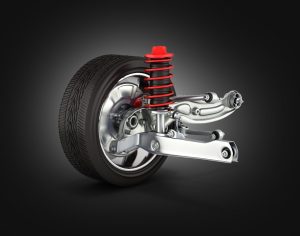The suspension system is one of the most critical components in any vehicle, and at the heart of this system lies a humble yet powerful part — the suspension spring. From the early days of motoring to the advanced systems found in modern electric and luxury vehicles, suspension springs have undergone significant evolution, transforming in materials, structure, and intelligence.
This article explores the fascinating journey of car suspension springs — from traditional steel coils to cutting-edge smart systems — and explains how these changes have impacted vehicle comfort, handling, safety, and performance.
What Are Suspension Springs?

Suspension springs are essential elements that:
-
Absorb and dissipate energy from road irregularities
-
Maintain ride height and stability
-
Work with shock absorbers to reduce body movement
-
Ensure consistent tire contact with the road
They determine how a car handles bumps, turns, and even emergency stops.
Historical Overview: Suspension Spring Evolution
Let’s take a chronological look at how suspension springs have developed over the years.
| Era | Spring Type | Vehicle Use | Key Characteristics |
|---|---|---|---|
| Pre-1920s | Leaf springs | Horse carriages, early cars | Simple, multi-layered metal bands |
| 1920s–1950s | Coil springs (steel) | Mass-produced sedans | Compact, affordable, easier to integrate |
| 1960s–1980s | Torsion bars | Trucks, military, sports | Adjustable stiffness, space-saving design |
| 1990s–2000s | Air suspension | Luxury & utility vehicles | Height adjustable, superior ride comfort |
| 2010s–Present | Composite & smart springs | EVs, performance cars | Lightweight, electronically adaptive |
Types of Suspension Springs
1. Leaf Springs
One of the earliest spring designs, still in use today in heavy-duty vehicles.
Pros:
-
High load capacity
-
Simple and durable
Cons:
-
Heavy
-
Less comfort and precision
2. Coil Springs
The most common type used in passenger vehicles.
Pros:
-
Compact design
-
Good ride comfort and handling balance
Cons:
-
Fixed characteristics unless paired with advanced dampers
3. Torsion Bars
These use twisting metal rods to provide spring action.
Pros:
-
Adjustable ride height
-
Space-efficient
Cons:
-
Can be harder to tune for varying road conditions
4. Air Springs
Use compressed air in flexible bellows.
Pros:
-
Height adjustability
-
Smooth, luxury-level ride
Cons:
-
Expensive and complex
-
Sensitive to leaks and cold weather
5. Composite and Smart Springs
Made from advanced materials or embedded with sensors.
Pros:
-
Lightweight and corrosion-resistant
-
Real-time adaptive damping when integrated into smart systems
Cons:
-
High development and production costs
Modern Innovations in Suspension Springs
Composite Springs
Used in high-performance and electric vehicles (e.g., Corvette, Audi A6 Avant e-tron).
-
Made from fiberglass-reinforced polymers
-
Up to 60% lighter than steel
-
Resistant to corrosion and fatigue
Air Suspension with Electronic Control
Found in luxury models like Range Rover, Tesla, and Mercedes-Benz.
-
Height adjusts automatically or via drive modes
-
Optimizes aerodynamics and comfort
Smart Suspension Systems
Incorporate sensors and actuators into the suspension, often paired with adaptive dampers.
-
Real-time spring rate adjustments
-
AI-based behavior for driving styles and road surfaces
| Feature | Standard Springs | Smart Systems |
|---|---|---|
| Weight | Heavier (steel) | Lighter (composite/air) |
| Comfort | Consistent, fixed | Adaptive to road conditions |
| Load adjustment | Manual | Automatic (electronically controlled) |
| Cost | Lower | Higher (luxury/performance) |
| Use cases | Mass market vehicles | Premium, EVs, off-road |
Why Spring Evolution Matters
Changes in spring technology aren’t just for innovation’s sake. Each step forward brings:
-
Improved fuel efficiency (or battery range) from lighter components
-
Enhanced handling through dynamic ride tuning
-
Better load distribution, especially in EVs and hybrids
-
Reduced NVH (Noise, Vibration, and Harshness) for modern quiet cabins
Common Issues with Older Spring Systems

If you drive an older car or haven’t replaced springs in years, here are some signs of wear:
-
Sagging or uneven vehicle height
-
Noisy, bumpy ride
-
Poor cornering stability
-
Visible corrosion or cracking on coils or leaves
Modern alternatives offer improved performance, comfort, and longevity over aging traditional systems.
Upgrade Your Suspension the Right Way
Whether you’re restoring a classic, upgrading a sports car, or maintaining your daily driver, choosing the right suspension spring is key to ride quality and safety.
Buy Springs & Components online
Explore a wide selection of coil springs, air suspension parts, leaf springs, and more — compatible with all major car brands. Use the online compatibility checker for quick matching and fast EU-wide delivery.
Final Thoughts
From basic steel coils to intelligent air-assisted and composite systems, car suspension springs have come a long way. These advancements not only reflect automotive progress but also enhance every aspect of the driving experience — from comfort and efficiency to control and safety.
Understanding this evolution helps drivers make informed decisions when replacing or upgrading suspension parts. It’s more than just metal and mechanics — it’s the science of keeping your wheels on the road and your journey smooth.
So whether you’re planning a suspension overhaul or simply staying informed, remember that today’s spring technology is smarter, lighter, and more capable than ever before.
Ready to upgrade your ride?
Buy Springs & Components online and choose parts designed for the roads — and vehicles — of today and tomorrow.